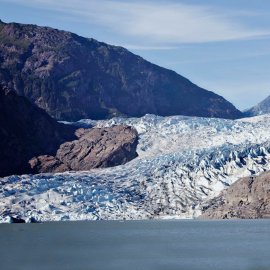Ocean Literacy: The Ocean Shapes the Features of the Earth
-
English
-
ListenPause
[intro music] Welcome to World Ocean Radio… I’m Peter Neill, Director of the World Ocean Observatory. We are discussing Ocean Literacy. Here is a premise on which a new understanding of and curriculum for the ocean can be based: The ocean and life in the ocean shape the features of Earth. Well yes, and in how many ways does this occur? First, there is the geological record of forces above and below the sea that have moved glaciers, shifted tectonic plates, and eroded and augmented the shape of the land, sometimes over eons, sometimes overnight. Wave action and currents are like blades of force that carve and curve the shore, build and un-build the coast, and define landside response by such change, the addition of land, the subtraction of land, the deposits and sediments left behind, and the capacity of the terrestrial environment to support life in all its forms and functions. Science helps us document this change—cartography, for example, the continuous record by maps and charts of the features of land and sea as they change over time. From the beginning, humans endeavored to answer the question: where am I, in space and time? Thereby through memories, documents, specific explorations and expeditions, and ever-technical and accurate renderings, locating, orienting, envisioning, and planning routes from one place to another. In our era of comprehensive observing and collecting of data, this documentary understanding of the features of earth and ocean has become more complete, detailed, and beautiful. Another shaping force of the ocean is the associated consequences of environmental change. Land once underwater is revealed; glaciers leave grinding, striated marks on land and rocky shores; the leavings coalesce as resources to be extracted as value; the success and failure of plant life is advanced as food or medicine; and the habitability of places is destroyed into history or enhanced into the future of civilization. Natural resources define watersheds, from mountaintops to streams, lakes and rivers; where rivers meet the shore, safe anchorages are found; safe harbors become ports; ports become centers of settlements; settlements become nodes of production, trade, and international connection. If the ocean is defined as a hydraulic continuum—from fresh water to saltwater and around again—then it can be claimed to the most direct and impactful shaping force there is. The ocean shapes our lives every day through the impact of fisheries as a protein harvesting industry, at large and small scale, the world over. We have nations, towns, and villages that have been founded on and sustained for centuries through coastwise and offshore catch in many forms to feed us and promote our well being as individuals and communities. The ocean is also a vast pharmacopoeia, an inventory of literally millions of plants and animals that we know or remain to be discovered. Coral reefs, for example, contain biological and chemical diversity that may hold the cure to diseases beyond imagination, some of which might well be the result of over-population, other unthinking interventions into natural processes, or engendered by activities and other so-called advancements with consequences unforeseen. So much about the ocean remains unknown. So much of what it has provided in the past is at risk. So much of its value may serve us still through continuing research and scientific analysis as we continue to study, understand and implement. Finally, the ocean has shaped our cultures and beliefs. We can see the history of fisheries, for example, in the monuments and architecture of coastal towns: stone tablets listing fishers lost at sea; stories, songs, and poetry describing and remembering sea experience; wharves and buildings that once supported the transfer of fish products from catch to table, from villages to cities, and from there to cities elsewhere inland or for international exchange; Captains’ houses, votive ships and stained glass scenes in local churches; logs and accounting books; rituals and beliefs, baptisms and burials, sagas and myths, all shaped by the ocean. To be literate about the ocean is to be open to and knowledgeable of everything thereby connected. We will discuss these issues, and more, in future editions of World Ocean Radio. [outro music]
Part 3 of 9 of the Ocean Literacy Series "The ocean and life in the ocean shape the features of Earth." So states the second principle of the ocean literacy curriculum, a series of fundamental concepts to help us better understand the ocean's influence on us and our influence on the ocean. World Ocean Radio's Ocean Literacy series continues this week with an overview of the various ways that the one oceanic system shapes the terrestrial landscape, the environment, the watersheds, plant life, and human existence. This episode is part three of a nine-part series on Ocean Literacy, an anthology of reflections, examples and illustrations that represent responses to the ocean and the environmental challenges we face.
About World Ocean Radio
Peter Neill, Director of the World Ocean Observatory and host of World Ocean Radio, provides coverage of a broad spectrum of ocean issues from science and education to advocacy and exemplary projects. World Ocean Radio, a project of the World Ocean Observatory, is a weekly series of five-minute audio essays available for syndicated use at no cost by college and community radio stations worldwide.
Image
Mendenhall Glacier, Juneau, Alaska. Wikimedia Commons.
Resources
Ocean Literacy Curriculum
About the Ocean Literacy Principles
- Login to post comments



